Anime Fans, Furries, and Fantasy Sport Fans – Together at Last!
Earlier this year our research team began work on a unique project: To investigate the similarities and differences between three different fandoms: Anime Fans, Furries, and Fantasy Sport Fans. Data collection and entry took nearly six months and, among other things, included attending two different fan conventions on opposite sides of the country, recruiting thousands of people for online studies, and putting together a database containing more than 1.1 million individual pieces of data.
What follows is a summary of our research team’s early findings. A complete write-up of all of our results is impossible, given that the database itself contains more than 225 variables and, as such, just looking at all of the possible simple relationships between two variables in the dataset would entail more than 50,000 separate analyses (not including the more complex analyses we regularly conduct). To keep this write-up manageable, we’ve tried to present the findings we think readers will find the most interesting, based on questions we’ve been asked by people interested in our research.
If you have questions, concerns, or criticisms about the presented findings, or would like us to run an analysis to satisfy your own curiosity, please e-mail Dr. Courtney Plante at courtney.plante@furscience.com .
Methods: What did you actually do?
The data we analyzed came from four sources across three different fandoms. First, a description of the fandoms:
Anime fandom: Anime fans are people who self-identify with their interest in anime, a style of Japanese animation targeted to both children and adults. While fans typically identify with an interest in one or several particular series, content itself ranges from children’s programming to adult (violent or pornographic), from realistic to the realm of science fiction (e.g., mecha, advanced technology, spacefaring), fantasy (magic, mythical creatures, spirituality), or alternate history, and spans a numerous media formats, including manga (graphical novels), television shows, and film. Fan-made content plays a significant role in the anime community, with fans producing unique works of fan art, fan fiction, and elaborate cosplay. The fandom also has a significant online presence, with anime fans sharing content and ideas in online forums, discussion boards, and across social media. The fandom also has a significant real-world presence, with school-wide or even city-wide anime clubs and regional anime conventions ranging in size from several hundred attendees to more than 50,000. Finally, the fandom itself frequently overlaps with other aspects of “geek” culture, including gaming (board, card, and video), internet culture, and science fiction / fantasy.
Furry fandom: Furry fans, or “furries” are people who self-identify with an interest in anthropomorphism (giving human traits to animals) or zoomorphism (giving animal traits to humans). Interests in anthropo/zoomorphism manifest themselves in diverse ways, ranging from the production or admiration of artwork (which, itself, ranges from children’s cartoons to violent and sexual themes) to the construction and wearing of elaborate, full-body fursuits (mascot-style costumes), and includes furry-themed music, animation, games, and writing. The vast majority of furries develop a furry-themed avatar, known as a “fursona”, to represent themselves when interacting with other members of the fandom. Fursonas typically involve one or more species (e.g., wolf, fox, dragon, dog, cat, etc…), a name, and, in many instances, clothing, personality traits, and narratives. The furry fandom is a largely online fandom, with furries interacting through social media, online forums, and art-sharing websites . Furries also gather in-person at local meet-ups and at regional furry conventions, which range in size from several dozen attendees to more than 5,000 attendees.
Fantasy sport fandom: Fantasy sport fans are typically sport fans who play the role of a sport team manager and build their own fantasy teams based on rosters of existing, real-world players. They compete with other managers in leagues that range from small, private leagues among friends and co-workers to elaborate public leagues that span the country. Performance of a manager’s team depends on the performance of real-world players, leading fantasy sport fans to regularly keep track of sport statistics to track their performance in their league and to inform their decisions to trade, cut, or sign new players to their team. Common sports in fantasy sport fandom include football (American and soccer), basketball, baseball, hockey, and cricket. Fantasy sport is a growing fandom, aided in large part by the internet and the ability to connect with other fantasy sport fans, and the fantasy sport fandom itself is estimated to be a multibillion dollar industry worldwide.
Data on each fandom were collected from 4 sources:
Anime fans (2 sources) – A) Surveys were passed out to attendees at A-Kon 2014, an anime convention in Dallas, Texas from June 6-8th with more than 26,000 attendees. In total, 901 surveys were collected at A-Kon. B) An online version of the same survey was completed by 2,283 people recruited from various anime-themed websites online (e.g., forums, discussion boards).
Furries – Furry participants were recruited at Anthrocon 2014, the world’s largest annual furry convention in Pittsburgh, Pennsylvania from July 3-6th with more than 5,800 attendees. In total, 1,059 surveys were collected.
Fantasy sport fans – Fantasy sport fans were recruited through Amazon’s Mechanical Turk, a crowdsourcing site allowing users to complete online tasks for money. As a requirement for participating, participants had to self-identify as a fantasy sport fan. In total, 511 surveys were collected.
All participants were over the age of 18, as required by our ethics review board, and all participants’ information was contributed anonymously and confidentially.
Participants across all four sources completed nearly-identical versions of the same survey. By having participants answer the same questions, we are able to look at similarities and differences between participants identifying with different fandoms (and, in the case of anime fans, to identify differences between convention-going fans and online fans). Small differences existed between the questionnaires, including slight wording changes, where relevant (e.g., “as a furry fan” vs “as an anime fan” vs “as a fantasy sport fan”).
Results: Get to the Data!
The results of our findings are presented with the aim of making them as accessible as possible to everyone reading. As such, we are displaying these results with a target audience that has little to no statistical understanding. To ease interpretation of data, we use a color-coding system: when two groups are considered “statistically similar”, they are colored with the same color. When two different groups differ statistically from one another, they are colored with different colors (e.g., blue and red).
For those who are more stats-savvy, most of the results below involved conducing ANOVAs using the stats program SPSS. Significance-testing was conducted using post-hoc testing, specifically the Tukey Least-Significant Difference procedure. Other statistical techniques we employ in our analysis of the data include simple t-tests, regression analysis, exploratory and confirmatory factor analysis, and structural equation modeling. For more information on these or about any of our analyses below, please contact Dr. Courtney Plante at courtney.plante@furscience.com .
Demographics
1. Do anime fans, furries, and fantasy sport fans differ in age?
Short answer: Yes – Anime fans are the youngest of the three groups, followed by furries, and then by fantasy sport fans.
Long answer: Online anime fans were the youngest group, and were significantly younger than convention-going anime fans. This is not a particularly surprising finding: Going to a convention costs money, something that usually requires expendable income and, in many cases, transportation to the convention. As such, it is more likely that older anime fans (e.g., in their mid-20s) will have the resources and means to attend a fan convention than younger anime fans. In contrast, online anime fans only require a computer and internet access, making it more accessible to younger fans. Anime fans, con-going or online, were significantly younger than con-going furries. Finally, fantasy sport fans were, on average, far older than either anime fans or furries, with the average fantasy sport fan being in their 30s. This may indicate that fantasy sports, as a hobby or interest, may be targeted toward older fans.
2. Do anime fans, furries, and fantasy sport fans differ in biological sex (gender assigned at birth)?
Short answer: Yes and no. While the fandoms are all generally male-dominated, convention-going anime fans are far more likely to be closer to a 50/50 split between males and females. Transgender individuals are much more prominent in the furry fandom than in the other fandoms.
Long answer: All four samples showed that males were more prevalent than females. This discrepancy was approximately equal for all samples except for the A-Kon sample, which, while still more male than female, was far closer to equal in proportion. This may suggest that female anime fans are more drawn to conventions than male anime fans, though the reason for this is yet unknown – perhaps conventions are more appealing than the online anime community, or perhaps the sorts of fan activities available at conventions (e.g., attending panels, cosplaying, meet-and-greet / autograph sessions) are more appealing to female anime fans than the fan activities available online.
Another interesting observation is the relative prevalence of transgender individuals in the furry fandom as compared to individuals in the other fandoms: more than twice as many convention-going furries identified as transgender as convention-going anime fans. While there was a higher proportion of transgender individuals in the online anime sample than the A-Kon sample, it was still significantly less than in the furry sample. Whether this indicates fandom-level differences in the inclusiveness of the two fandoms or perhaps a preferential pull toward some other aspect of the furry fandom remains a subject for future research.
An open-ended option, “other” was also included in this question. Results from these questions were relatively idiosyncratic (and are not displayed to avoid the identification of participants).
3. Do anime fans, furries, and fantasy sport fans differ in their self-identified gender?
Short answer: Yes. Group-wise, furries have the highest proportion of “gender bending” (that is, assigned-at-birth males self-identifying with the female gender, and vice-versa), whereas sport fans have the least gender bending. Anime fans fall somewhere in-between, with convention-going anime fans being more likely to gender bend than online anime fans.
Long answer: In addition to questions asking about a person’s assigned sex at birth (shortened here to “biological sex”), we asked participants about their self-identified gender – a socially constructed identity. Gender was assessed along a 5-point continuum ranging from “1 – Completely Masculine” to “5 – Completely Feminine”. We looked at biological males and females separately, looking at the extent to which they engaged in gender bending behaviour (on the figures above, higher numbers indicate greater gender bending). The most gender bending occurred in the furry fandom, while the least occurred in the fantasy sport fandom. The anime fandom was in-between these two, with convention-going anime fans being more likely to gender bend than online anime fans.
We also looked at the percentage of respondents who indicated that they identified themselves in another way (that is, a way that didn’t fall on the Masculine-Feminine dimension we provided). Furries were the most likely to respond that they did not consider their gender identity to fall within this traditional gender dimension, with convention-going anime fans to be about half as likely to do so. There were no participants in either the online anime or sport fan samples who self-identified outside of the gender dimension provided.
As a whole, these data may suggest that of the three fandoms, the furry fandom is the one most open to, or accepting of, people who eschew or challenge traditional gender norms (as indicated by the most gender bending and the most people who identified as “other”). This may, in part, have to do with the content of the furry fandom, which allows a person’s created fursona to be any species, age, or gender, they wish – something that may appeal to people who otherwise feel limited in their ability to express their felt gender identity. Interestingly, convention-going anime fans were more likely than online anime fans to gender bend and to self-identify outside of the masculine-feminine dimension. The reasons for this are currently unknown, and a topic of interest for future research.
4. Do anime fans, furries, and fantasy sport fans differ in their sexual orientation?
Short answer: Yes, resoundingly. By far, furries were far more likely to be members of sexual minorities, including being more likely to self-identify as bisexual, homosexual, asexual (along with online anime fans), or with other orientations (e.g., pansexual). In contrast, fantasy sport fans were the most likely to be heterosexual and the least likely to self-identify as a member of a sexual minority. Convention-going anime fans were more likely to self-identify as a member of a sexual minority than online anime fans. Finally, unlike in anime or fantasy sport fandom, where women were more likely to identify with a non-heterosexual orientation, in the furry fandom, males were far more likely to self-identify with a non-heterosexual orientation.
Long answer: We assessed sexual orientation of participants using a modified variant of the classic Kinsey scale of sexual orientation. In this scale, sexual orientation was conceptualized as a continuous dimension, ranging from “Exclusively heterosexual” to “Exclusively homosexual”, with varying degrees of “bisexuality” in the middle of the scale (for present purposes, “bisexual” is referring to the midpoint of the scale, though the authors acknowledge that there are other definitions of bisexuality one could employ). Participants indicated their sexual orientation on a scale ranging from “1 – Exclusively Heterosexual” to “7 – Exclusively Homosexual”. Participants also had the option to instead select “Asexual”, or “Other”, and to provide an open-ended response (specifics regarding these data are not presented to protect the anonymity of participants).
Fantasy sport fans were the most likely to self-identify as exclusively heterosexual, with the vast majority of participants in this group identifying as exclusively heterosexual and only relatively few self-identifying as members of a sexual minority. In contrast, anime fans were far less likely to self-identify as completely heterosexual, with convention-going anime fans being less likely than online anime fans to do so. Follow-up analysis revealed that many anime fans (~15%), while not selecting “exclusively heterosexual”, did select the second option, “predominantly heterosexual, only incidentally homosexual”. Convention-going anime fans were significantly more likely than online anime fans to self-identify as either bisexual or exclusively homosexual. Furries, by comparison, were the only group where less than half of the group (in fact, less than a quarter of the group!) self-identified as exclusively heterosexual. In fact, furries were 2-6 times more likely to self-identify as bisexual, and 3-10 times more likely to self-identify as exclusively homosexual as the other groups. Furries were also more likely to self-identify with an “other” sexual orientation. Both furries and online anime fans were the most likely to self-identify as asexual.
Interestingly, the fan groups differed in the extent to which men and women (that is, people who were assigned “male” or “female” genders at birth) self-identified their sexual orientation. In the fantasy sport group and both anime fan groups, females were more likely than males to self-identify as non-heterosexual (as indicated by higher numbers on the sexual orientation scale). In contrast, in the furry fandom, males – not females – were more likely to self-identify as non-heterosexual.
It may be the case that the furry fandom, which espouses openness and acceptance as its central virtues, may be a particularly welcoming place for members of sexual minorities. Alternatively, the openness and acceptance of the furry fandom may allow people who consider themselves to be exclusively heterosexual to explore aspects of their sexuality they may otherwise not consider in other contexts. Ultimately, future research is needed to explore the nature of these interesting gender and fandom differences in sexual orientation.
5. Do anime fans, furries, and fantasy sport fans differ in their ethnicity?
Short answer: Yes. While all of the studied groups were predominantly White, furries were proportionately the most White, while anime fans were the least, with fantasy sport fans falling somewhere in-between. Online anime fans had the highest proportion of Asian participants, while A-Kon had the highest proportion of Hispanic participants.
Long answer: Furries, as a group, were the most predominantly white, having relatively fewer members of ethnic minorities compared to the other groups. The reasons for this are unknown, though it may be the case that the historical origins of the furry fandom (grounded in the science-fiction fandom which has also been traditionally white) may partially explain these findings. In comparison, convention-going anime fans had a significant Hispanic population, likely owing to the convention’s location in Dallas, Texas, a region with a large Hispanic population relative to other parts of the country. This is supported by the relatively smaller proportion of Hispanic participants in the online anime sample, which represents online participants from far more diverse regions. Interestingly, the online anime sample had significantly more Asian participants, something one would expect in a fandom centered around Japanese animation, although there were unexpectedly few Asian participants at A-Kon (likely owing to population demographics of the surrounding area). I have also provided the data collected for Black participants, though distinct trends in these data and the reasons for them seemed less apparent than for other ethnic groups.
6. Do anime fans, furries, and fantasy sport fans differ in their relationship status?
Short answer: Yes. Online anime fans were the most likely to be single, while fantasy sport fans were the least likely to be single, with furries and convention-going anime fans in-between. Fantasy sport fans were the most likely to be married, while furries and convention-going anime fans were the most likely to be dating. Finally, furries were uniquely high in their openness to open relationships or polyamory, although convention-going anime fans were also open to these types of relationships to a lesser extent.
Long answer: Age likely plays a significant factor in these results – the older a person is, the more likely they are to be married, especially when the age difference is between someone in their early 20s and someone in their early 30s (given that the average age of marriage is currently in a person’s late 20s). As such, it’s unsurprising that fantasy sport fans, as the oldest fan group on average (see #1) are the most likely to be married and, by extension, the least likely to be single. Along similar lines of reasoning, it also makes sense why online anime fans, as the youngest group, are the most likely to be single and not in a long-term dating relationship. Furries (a convention-going sample), and convention-going anime fans were comparable in their rates of dating, although the A-Kon sample was more likely to be single than furries.
This brings us to another category of interest: open relationships and polyamory. While we acknowledge that these are two distinct (if related) phenomena, results for the two items were comparable, and so they were grouped together in the above figure. As a group, furries are far more likely to engage in open relationships or polyamory than the other groups, although convention-going anime fans were significantly more likely to engage in these moreso than online anime fans or fantasy sport fans. One possible explanation for the high rates of polyamory in the furry fandom: one of the values of the furry fandom is an openness and acceptance of everyone, which may make it a particularly appealing, non-judgmental place for people who are in polyamorous or open relationships (which are often stigmatized in the general population). Alternatively, the open and accepting nature of the furry fandom may lead furries to consider open relationships and polyamory where, in other contexts, they might otherwise not. Further research is needed to clarify the possible mechanisms underlying these differences.
7. Do anime fans, furries, and fantasy sport fans differ on other demographic variables?
Short answer: Yes. Furries and online anime fans are more politically liberal and less religious than convention-going anime fans or fantasy sport fans. Fantasy sport fans, as a group, are better-educated than furries or anime fans.
Long answer: It should be noted that while furries and online anime fans identified as more politically liberal than convention-going and fantasy sport fans, all groups were above the mid-point on the scale, suggesting that all groups were more likely to identify as more liberal than more conservative. It may be the case that the convention-going anime fans were less liberal than online anime fans due to the location of the convention, Dallas, Texas, a particularly conservative part of the country. Similar trends may explain the differences between the groups with regard to religiosity. Interestingly, furries reported being more religious than online anime fans, a trend which may be explained by the fact that some furries associate their fursonas with spirit guides or shamanism (coupled with the fact that previous research suggests that 25% of furries self-identify as Christian).
Finally, the data suggest that, compared to the other groups, fantasy sport fans have more education, as measured on a 10-point scale. On average, furries and anime fans report having some college / university education or an associate’s degree, while fantasy sport fans were more likely to have some college / university education or to have completed their degree. This is, perhaps unsurprisingly, likely due to the age differences between the groups, as younger people are less likely to have completed a post-secondary degree.
Fandom Participation
8. Do anime fans, furries, and fantasy sport fans differ in how long they’ve been fans?
Short answer: Yes. Compared to sport fans, who reported spending the least time as a fan, furries and online fans reported having been a fan of their respective content for longer, while convention-going anime fans reported having been a fan the longest of the groups. Sport fans were also the oldest when they got into their fandom, while anime fans (particularly convention-going fans) were the youngest, with furries somewhere in the middle.
Long answer: Interestingly, fantasy sport fans report that they got into their interest at a much later age than did anime fans or furries and, in a similar vein, they had spent fewer years as members of this fandom. In part, this may have to do with the rise in prominence of fantasy sports in the past few years and its rapid increase in popularity through both the internet and television shows like “The League”.
Anime fans became fans at the youngest age, perhaps, in part, due to the vast amount of anime television programming targeted at children (e.g., Pokémon) as compared to furries, many of whom, past research has found, only discovered the existence of the fandom in their later teenage years as a result of the internet. It is also worth noting that convention-going anime fans reported having been an anime fan significantly longer, and reported having gotten into the fandom younger than online fans. The former result is likely due to the fact that convention-going anime fans were older than online anime fans, while the latter result is harder to explain, and may be the subject of future research.
9. Does the content consumed by anime fans, furries, and fantasy sport fans differ? How?
Short answer: Yes. Compared to the furry and fantasy sport fandoms, the anime fandom is associated with far greater ownership of videos, a difference which is less prominent when it comes to print media (e.g., visual art, magazines, books). Compared to the other groups, the content of the furry fandom is more likely to be divided, with furries reporting more content targeted toward kids (e.g., Disney movies, kids cartoons) and more pornographic content (e.g., explicit artwork) than the other groups, although furry content is considerably less violent than the other groups. Convention-going anime fans report owning more manga / artwork than online anime fans, and report that the content they own is more likely to be violent or pornographic in nature than online anime fans.
Long answer: A significant component of anime fandom is organized around studios and companies that put out television shows and movies. As such, it is unsurprising to see that anime fans, whether online or convention-going, own far more video-based content than either furries – where the fandom largely consists of drawn artwork produced by independent artists – or fantasy sport fans – whose interest in sports manifests by watching the games themselves or managing their teams, not collecting and watching videos about sports. In contrast, print media, including magazines, books, and artwork, are much more prevalent in all three fandoms. Interestingly, in this regard, only convention-going anime fans stood out. Perhaps buying manga and artwork is something more available to convention-going anime fans, who may have more expendable income than online anime fans, although this would not account for the difference between convention-going anime fans and furries who, in this case, were also a convention-going sample. It is possible that the inclusion of “manga” in this category – something present in Anime culture but which is largely absent in furry culture, accounts for this difference.
When it comes to fandom content, furries and convention-going anime fans are the most likely to report owning content that is targeted toward children. Follow-up analyses revealed that, at least for convention-going anime fans, the younger a fan was when they got into the fandom, the more likely they were to own content targeted towards kids (B = -.09, p = <.001). The same was not true for furries (B = -.02, p > .50). Future research may help to discern the reason for this finding.
Given the often violent nature of many anime shows (which often feature fighting robots, swords and gunplay, and fighting / martial arts), it is unsurprising that, relative to furry participants, anime fans reported being more likely to own violent content. Similarly, given that aggression is inherent in many sports (e.g., football, hockey), these findings are also unremarkable.
With regard to pornography, furries were significantly more likely than the other groups to own pornography-themed content, nearly always in the form of drawn artwork, often portraying one’s own fursona and/or other characters/fursonas. Interestingly, convention-going anime fans were more likely to own pornographic content than online anime fans, perhaps owing the ability to commission artwork or to being older and more likely to live on one’s own. Given the focus of fantasy sports on sports themselves and team management, it is unsurprising that very little content in this fandom would be deemed “pornographic”.
10. Does the anime, furry, and fantasy sport fandoms differ in terms of the number of artists and writers in the fandom?
Short answer: Yes. Online anime fans were the least likely to self-identify as artists or as writers. Furries were the most likely to self-identify as artists, while convention-going anime fans were the most likely to self-identify as writers.
Long answer: Given that the furry fandom is a predominantly visual art fandom, and given that the fandom’s content centers around independent artists as opposed to large studios, it is unsurprising that furries were the group most strongly self-identifying as artists. Convention-going anime fans were significantly more likely to self-identify as artists and as writers as compared to online anime fans, possibly due to the fact that many convention-going anime fans may have been artists or writers trying to sell artwork or trying to form social networks with other artists in the fandom. Interestingly, convention-going anime fans were the most likely to self-report writing, which may be a product of the popularity of fan-fiction in anime fandom. Interestingly, sport fans were also likely to self-identify as writers (relative to online anime fans, and comparable to furries), for reasons currently unknown.
11. Do anime fans, furries, and fantasy sport fans differ in the extent to which they surround themselves with like-minded others?
Short answer: Yes-and-no. Members of all fandoms tended to surround themselves with others who shared their interests – across fandoms, about half of fans’ friends were also reported to be fans. That said, there were some differences: Convention-going anime fans were the most likely to have friends who were also anime fans, while online anime fans were the least likely to have friends who were also anime fans.
Long answer: Convention-going anime fans were the most likely to have friends who shared their interests. This may be due, in part, to the fact that the interests of anime fans are more mainstream than, say, furries, making it easier to find friends who share your interests. Moreover, convention-going fans report having been fans for longer than the other groups (see #7), giving them more time to meet others who share their interests. Finally, there may be selection bias occurring, in that convention-going fans may be people who had enough friends who shared their interest to be able to pool resources and be able to afford going to a convention (travel costs, hotel, etc…).
Interestingly, follow-up analyses suggest that furries and convention-going fans did not differ in the number of friends that they reported having (and, indeed, both groups reported having significantly more friends than online anime fans or fantasy sport fans). As such, the difference in proportion of friends who are fans between the two groups seems to be driven by the fact that more of the convention-going anime fans’ friends were fans. Future research may attempt to address the differences between different fandoms in the composition and structure of their social networks.
12. Do anime fans, furries, and fantasy sport fans differ in their sense of entitlement (e.g., expectations they have toward content creators / important people in their fandoms)?
Short answer: Yes – of the fan groups, furries are the most entitled group, while online anime fans and fantasy sport fans were the least entitled groups, with convention-going anime fans somewhere in-between.
Long answer: We measured fan entitlement using a 7-item scale where participants indicated the extent to which they agreed or disagreed with statements regarding their feelings toward content creators or important people in their respective fandoms (e.g., artists, players). Statements included beliefs about receiving special treatment or the fan’s right to criticize. Higher scores indicate a greater sense of entitlement – that is, a feeling that one is owed or has a right to something from these people by virtue of being a fan. Furries scored the highest on this scale, reflecting concerns raised by artists in our prior research about feelings of entitlement from people commissioning artwork from them. In part, this may be due to the fact that the furry fandom’s relatively small size and interconnectedness makes artists and content creators seem more accessible. In contrast, fantasy sport fans and online anime fans showed the least feelings of entitlement, perhaps reflecting perceived distance between fans and important people within these fandoms – professional athletes and professional artists may be less accessible in these fandoms. Convention-going anime fans fall somewhere in the middle, which may be a product of intermediate distance perceived between the fans and important people in the fandom (e.g., being able to see them in-person at a convention). Further research is needed to test this possible mechanism.
13. Do anime fans, furries, and fantasy sport fans differ in their nerdiness?
Short answer: Yes. When it comes to factors stereotypically associated with being a “nerd” (e.g., bookishness, social awkwardness, self-identifying as a nerd), convention-going anime fans scored the highest of the four groups, while fantasy sport fans scored the lowest. Furries and online anime fans scored approximately the same, somewhere between convention-going anime fans and fantasy sport fans.
Long answer: Believe it or not, there IS a nerd scale, which assesses the extent to which people identify with various aspects of the stereotype of being a nerd. Convention-going anime fans scored the highest on the scale, perhaps, in part, because they most closely fit the stereotype of a “nerd”, both with the intensity of their fan interest and given how well-known their interest (anime) is in society. In contrast, online anime fans, who may not spend the resources to attend an anime convention, may seem less like the stereotype of a nerd (e.g., “I like the shows, but I don’t dress up or spend hundreds or thousands of dollars to go to cons and hang out with other fans!”). Furries, while perhaps highly identifying with some aspects of the nerd culture, may less resemble the nerd stereotypes, given the relative lack of mainstream attention the furry fandom receives (they may be less associated with “nerd” culture and seen more as deviants – see #19 below). And finally, given that sports are considered mainstream and “normal”, fans of sports – even fantasy sports – may be unlikely to fit the stereotype of “nerd”.
14. Speaking of “nerdiness”, is there any evidence that anime fans, furries, and fantasy sport fans differ with regard to other aspects of “nerd” culture?
Short answer: Yes. Anime fans, compared to furries and fantasy sport fans, are more likely to frequently use a computer, play video games, and to speak Japanese, while fantasy sport fans are the least likely to do these things. Fantasy sport fans are also the most likely to watch sports of the four groups. Furries generally fall between the two extremes on these variables.
Long answer: We followed up our investigation of stereotypes of “nerd” culture by asking participants questions about their own behaviour – how much they agreed or disagreed with several items pertaining to nerd culture. While all groups indicated that they regularly used computers, online anime fans, perhaps unsurprisingly, scored the highest on computer use, followed by convention-going anime fans and furries, and finally fantasy sport fans. While online and convention-going anime fans differed with regard to computer use, they did not significantly differ in their videogame playing, with anime fans in general scoring higher than furries and fantasy sport fans with regard to playing video games. It should be noted how high these scores are (well above the scale’s midpoint), suggesting that the anime (and similarly, furry) fandom may overlap with other fandoms (e.g., gaming) as well.
Least surprisingly, fantasy sport fans reported the most frequent sport-watching behaviour, followed by anime fans and, finally, furries. These findings correspond with #16 below, which show that furries do not identify as sports fans as frequently as anime fans do.
Finally, given the association between anime and Japanese culture, not to mention the fact that anime fans were more likely to be Asian (particularly online anime fans, see #5) than the other fan groups, it is unsurprising that anime fans (particularly online anime fans) where the most likely to say that they spoke Japanese.
15. What motivates anime fans, furries, and fantasy sport fans?
Short answer: The data suggest the furries are more motivated by a sense of belonging and self-esteem than anime or fantasy sport fans. Anime fans, on the other hand, are the most likely to be motivated by the pursuit of entertainment. Furries were also more likely to be partially motivated by sex (that is, attraction to pornographic material) than the other groups, though it is worth noting that, of the motivations studied, sex was the least-frequently listed fan motivation.
Long answer: We asked participants to indicate to what extent they were motivated to participate in their respective fandoms for a variety of different reasons on 7-point scales (higher numbers indicating that a reason was a stronger motivator to participate). While “entertainment” was the strongest reason for all participants to participate, it was the strongest for anime fans, regardless of whether they were taken from the online sample or the convention-based sample. This suggests that anime fans, compared to the other samples, were the most motivated by entertainment.
In contrast, furries were more likely to list other reasons motivating their fan interest. Belongingness and self-esteem were seen as bigger motivators than anime fans or fantasy sport fans, though it is worth noting that convention-going anime fans were more likely than online anime fans to cite belongingness and self-esteem as motivation to participate. Given that prior research has suggested the importance of the furry fandom for identity development and social support to furries, it is unsurprising that they scored particularly high on these two motivations, suggesting that, for furries, their fan identity is motivated, perhaps more than the other groups, by more than just the entertainment associated with being a fan.
Finally, furries were also the most likely to report an interest in sex (e.g., pornographic content) as a motivator of fandom participation relative to the other groups (with convention-going anime fans being more likely than online anime fans to report sex as a motivator). While it may be the case that an interest in furry-themed pornography may somewhat motivate members of all of these fan groups, in none of the groups was it the case that sex was the primary motivator, suggesting that interest in sex may be secondary or a by-product of a person’s existing fan interest.
16. Is there overlap between the fandoms?
Short answer: Yes – Approximately 5-11% of anime fans considers themselves to be a furry, while 44% of furries consider themselves to be anime fans. Anime fans are more likely than furries to be sport fans (fantasy or regular sport fans).
| Sample | Furry YN? | Brony YN? | Anime Fan YN? | Sports Fan YN? | Fantasy Sport? |
| Furries | 86.3% | 21.1% | 44.0% | 10.5% | 0.3% |
| Online Anime | 4.5% | 6.7% | 90.8% | 19.1% | 5.8% |
| A-Kon | 10.7% | 15.2% | 83.2% | 14.6% | 4.8% |
Long answer: We asked participants across several of our samples (not our fantasy sport sample) whether or not they identified with other fan communities. Results suggested that a significant number of furries (nearly half) were anime fans, while a non-trivial number of anime fans were also furry (convention-going anime fans were about twice as likely to be furries than online anime fans). This suggests that there some overlap between these two fandoms. When looking at other fandoms, such as the “Brony” fandom (adult fans of the children’s television show “My Little Pony: Friendship is Magic”), about one-fifth of furries self-identified as bronies, while about 15% of convention-going anime fans (and about 7% of online anime fans) said they identified as bronies. Taken together, this suggests that despite the claims of many furries and anime fans, there may be some overlap, not just in content, but also in membership, between these two fandoms.
It is also worth noting that, compared to anime fans, furries were less likely to self-identify as sport fans, either fantasy sport fans or regular sport fans – a finding consistent with prior research on furries.
Psychological Variables
17. Do anime fans, furries, and fantasy sport fans have different personalities?
Short answer: Somewhat. The fandoms were comparable in terms of extraversion, agreeableness, and conscientiousness, with the exception that online anime fans were somewhat more introverted and more disagreeable than the other groups and fantasy sport fans were somewhat more conscientious than the other groups. Furries and online anime fans scored slightly lower on emotional stability than convention-going anime fans and sport fans. Finally, furries and convention-going anime fans were far more open to experience than online anime fans or fantasy sport fans.
Long answer: Participants in all groups were given the TIPI, the Ten-Item Personality Inventory (Gosling, Rentfrow, & Swann, 2003) that briefly assesses participants’ personalities on five dimensions frequently studied by psychologists: Extraversion (being energized by, and outgoing in, social experiences), Agreeableness (seeking social harmony, getting along with others), Conscientiousness (self-regulation, self-control), Emotional Stability (impulse control, security), and Openness to Experience (curiosity and seeking of novel people or situations).
Online anime fans scored the lowest of the groups on extraversion, agreeableness, and conscientiousness, suggesting that, relative to the other groups, they were more likely to be introverted, less opposed to interpersonal conflict, and to show less self-control than members of the other groups. Given that both furries and A-Kon participants were studied at conventions, it may be the case that these samples preferentially selected for outgoing, agreeable people who seek out others at conventions. Moreover, given that fantasy sport fans typically interact with others in fantasy sport leagues, this may explain why fantasy sport fans were comparably extraverted and agreeable. Given that prior research suggests there is an association between conscientiousness and age, it is unsurprising that online anime fans, the youngest group, were the lowest in conscientiousness, while fantasy sport fans, the oldest group, scored the highest. Furthermore, it is worth noting that the attention to detail and statistics required to participate in fantasy sports fandom may make it a particularly appealing activity for people high in conscientiousness.
With regard to emotional stability, furries and online anime fans scored slightly lower than convention-going and fantasy sport fans. This may reflect or partially explain the stereotypical association of internet-based fan cultures with “online drama” (given the predominantly online-nature of the furry fandom and the online anime fandom), though further research is needed to test both the veracity of these stereotypes and the possible underlying mechanisms.
Finally, both convention-going anime fans and furries scored significantly higher than online anime fans and fantasy sport fans on openness to experience. Given that one of the underlying values of the furry fandom is openness and acceptance, it makes sense that the fandom would be particularly enticing to people who are open to experience. Moreover, given the relative novelty of fan conventions (as compared to everyday life), it is not surprising that people attending fan conventions may be more open to experience than those who do not.
18. Do anime fans, furries, and fantasy sport fans differ in the extent to which they engage in fantasy-themed activities?
Short answer: Somewhat. Online anime fans seem to engage most frequently in fantasy-related activities, while fantasy sport fans seem to engage in fantasy-related activities the least. Furries and convention-going anime fans fell somewhere in-between these two groups.
Long answer: We assessed the frequency with which participants engaged in fantasy activities by first outlining examples of fantasy activities: Activities ranging from reading, playing video games, painting, watching movies, or thinking about how things in your life may have gone differently. Participants were then asked, on a 7-point scale ranging from “1 – Almost Never” to “7 – Several Times a Day”, how frequently they engaged in these sorts of activities. Online anime fans reported the most frequent fantasy engagement, followed by furries and convention-going anime fans, who did not differ significantly from one another, with fantasy sport fans engaging in the least fantasy engagement. Whether these differences are due to differences in motivation or desire to engage in fantasy, or whether they’re due to differences in the sorts of fantasy activities that members of each group considered is remains to be studied. A follow-up question asked participants to write down the activities they were thinking about, and so, in the future, we hope to code this information to see whether there are systematic differences in the types of fantasy activities members of the different fan groups engaged in.
19. Do anime fans, furries, and fantasy sport fans differ in their degree of social awkwardness?
Short answer: Not really. The three fandoms were pretty comparable in terms of social awkwardness experienced, although online anime fans were somewhat more socially awkward than the other groups.
Long answer: Social awkwardness was assessed using a 7-point scale where participants indicated their agreement or disagreement with various statements related to nervousness around others, awkwardness around other people, and shyness or embarrassment. Online anime fans stood out as being somewhat more socially awkward than the other groups. This is supported by above results (#13), where online anime fans were also the lowest in trait extraversion. Of the four groups, the online anime group is the group with the least expectation for social interaction – convention-going furries and convention-going anime fans are likely to interact with one another, while fantasy sport fans interact with others in their leagues. As such, rather than it being the case that being an online anime fan “causes” a person to be socially awkward, it may be the case that anime fans who are socially awkward may find convention-going to be an undesirable experience. Future research may look into testing the direction of this association.
20. Do anime fans, furries, and fantasy sport fans differ in their psychological well-being?
Short answer: Not really. On measures of life satisfaction, self-esteem, and depression, the three fandoms were relatively comparable, with the exception that online anime fans reported less life satisfaction and self-esteem than the other groups, while convention-going anime fans and fantasy sport fans scored lower on a measure of depression.
Long answer: We used three different measures of well-being to test whether participants across the three fandoms differed in their psychological well-being. Interestingly, the online anime fans reported slightly lower life satisfaction and self-esteem scores than members of the other fan groups. Psychological research on coping, resilience, and well-being has long suggested that having a social support network – family and close friends who are there for you, is a one of the most significant predictors of well-being. In above results (#11), it was shown that online anime fans have the smallest percentage of friends who share the same interest. This may suggest that online anime fans may rely less upon the other members of the fan community for social support, whereas, for furries, convention-going anime fans, and fantasy sport fans, they may be able to draw upon the fan community for social support, leading to greater psychological well-being.
In terms of felt depression, fantasy sport fans and convention-going anime fans scored lower than furries or online anime fans. These data are supported by findings on emotional stability (#13), which may suggest a plausible explanation for these findings: perhaps furries and online anime fans experience less emotional stability, in part due to being younger than, say, fantasy sport fans, and, as a result, this may contribute to experiencing depression. Of course, this is only one possible explanation for what is likely a multi-determined outcome, and so future research is needed to explore these fandom-level differences.
21. Do anime fans, furries, and fantasy sport fans differ in the extent to which they identify with their interest or with their fan groups?
Short answer: Yes – Of the fan groups, furries and convention-going anime fans report the most identification with their respective interests, although furries are even more likely than convention-going anime fans to identify with other members of their fan community. Additionally, fantasy sport fans are less likely to identify with their fan interests than online anime fans.
Long answer: Psychologists are beginning to recognize that there is a difference between fanship – identifying as a fan of something, and fandom – identifying as a member of a fan community. It is possible, for example, to be a fan of a particular television show (fanship), but to have little to no interest in interacting with other fans of the show (fandom). We included measures of both of these variables in our survey.
Unsurprisingly, furries (who were studied at a convention), and convention-going anime fans scored the highest on their identification as a fan. Given that they spent money and devoted the time to attending a convention, this suggests that they are more likely to be avid fans than members of an online fan community, a group which may contain (among more highly-identified fans), more casual fans. Put another way – there are fewer “casual fans” at a convention. Interestingly, fantasy sport fans scored relatively low on this scale, suggesting that while they may be interested in fantasy sports, it is less likely to be a defining or central characteristic of their identity.
Furries were the most likely to identify with other members of their community. Prior research has shown that furries frequently see themselves as a stigmatized community, with many furries reporting that the furry community was the first place they felt they “fit in”. As such, it makes sense that many furries highly identify with other members of the community. Convention-going anime fans also identify with other members of their fandom, albeit less than furries. Compared to online anime fans, convention-going fans may be attending conventions, at least in part, to interact with other members of the community. As such, this finding seems intuitive.
22. Do anime fans, furries, and fantasy sport fans expect to be treated differently because of their interests? Do they hide their fan identities from others?
Short answer: Yes – Furries are the most likely to expect non-furries to disapprove of their furry identity, while fantasy sport fans are the least likely to expect disapproval from others based on their interests. Anime fans were somewhere in the middle, and did not differ from each other, regardless of whether they were convention-going or online. In a similar vein, furries were the least likely to tell others that they were a furry, while fantasy sport fans and convention-going anime fans were the most likely to tell others about their interest. Online anime fans were less likely than convention-going anime fans to tell others about their anime fan identity.
Long answer: Furries have, historically, been on the receiving end of significant negative press, with inaccurate misrepresentations of the fandom frequently associating furries with sexual deviance or psychological dysfunction. As a result, furries, perhaps more than the other groups studied, experience the greatest concern regarding how non-furries would respond to the discovery that they were a furry, and furries indicated that they were the least likely of the groups to self-disclose their furry identity to others – family, friends, or co-workers. In contrast, the relatively “normal” nature of sports in our culture makes it more acceptable for fantasy sport fans to engage in their interests, explaining why they experience relatively little concern regarding how others will see them and relatively little concern with others knowing about their interest.
Interestingly, while online and convention-going anime fans did not significantly differ from one another with regard to perceptions of stigma toward them, they did differ in the extent to which they told others about their fan identity, with convention-going anime fans being more likely to disclose their anime fan status. It may be the case that, practically, anime fans are simply less able than online anime fans to hide their interests – owning cosplay materials or absences to attend a convention may be more noticeable to friends and family than going to anime websites or participating in anime discussion boards. This may explain these unexpected findings, although future research should test this proposed explanation.
Discussion – What now?
It’s worth noting that the vast majority of the findings presented above are preliminary or based on simple comparisons of averages. Moreover, the results displayed here represent only a subset of all of the variables studied.
We at the IARP are already hard at work pushing beyond these findings, looking for trends, explanations, mediations, and links between this work and existing work, as well as trying to figure out, by reviewing the existing literature, if these findings fill any holes in our current knowledge about fan research. At the moment, we have a number of ideas for possible publications, and hope to use this data – in conjunction with the other data not presented here – to ultimately improve our understanding of fan groups – whatever the fan group may be – and psychological processes.
Going forward, we will be sure to post links to updated analyses, new ideas, and any published articles that come from this data. And, as always, we remain open to suggestions and ideas, both for the existing data set and future research. It is never sufficient to just conduct one study, because there are no perfect studies. Research is a continuous process of trying to answer questions, and discovering new questions along the way. In a number of places we emphasized that the existing data raise additional questions to be addressed by future research, either our own or some other researcher down the line. These questions, and others like them, will be the goal of future studies.
If you have any questions about this data, or suggestions for future research, get in touch with us and let us know at: courtney.plante@furscience.com
Thanks again for your interest in our research, and be sure to share this site with others!

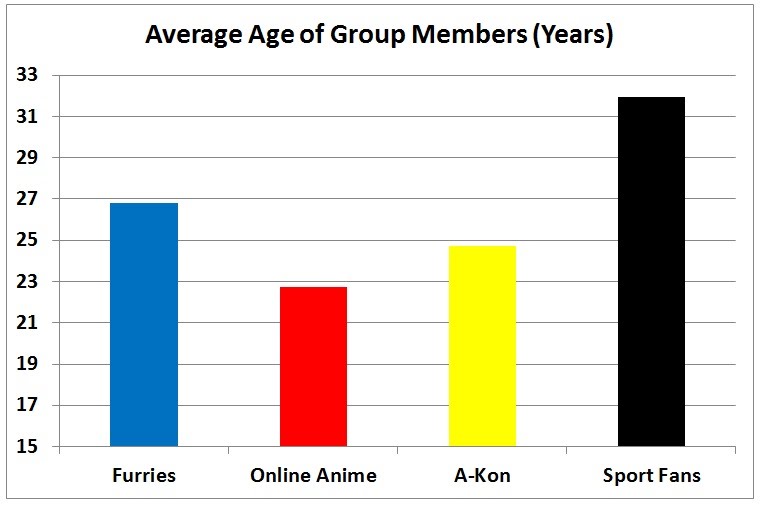
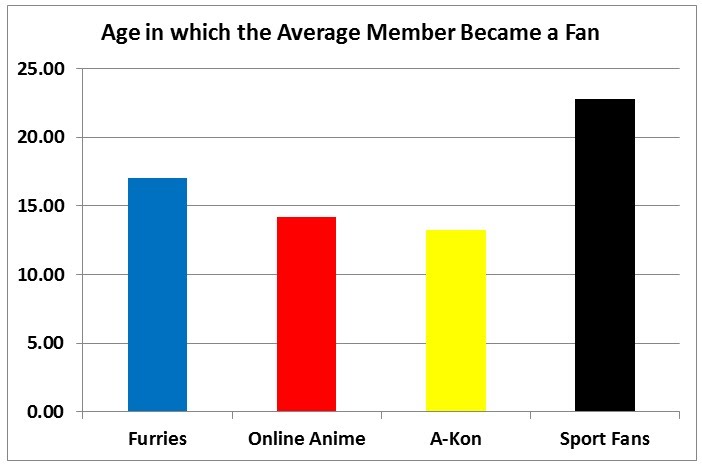
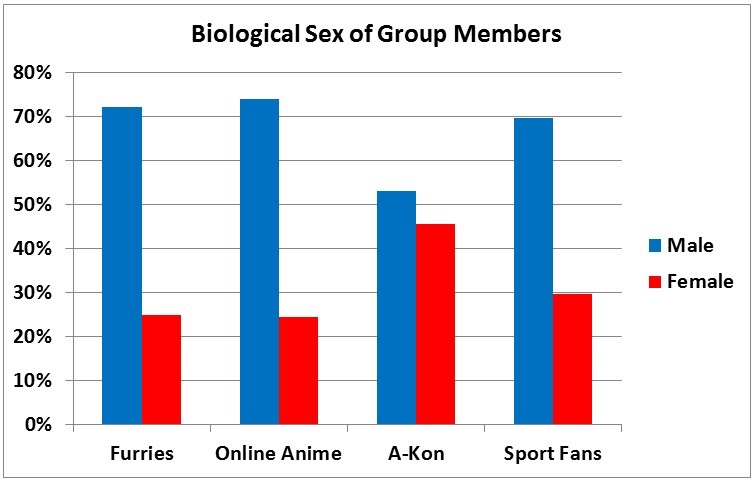
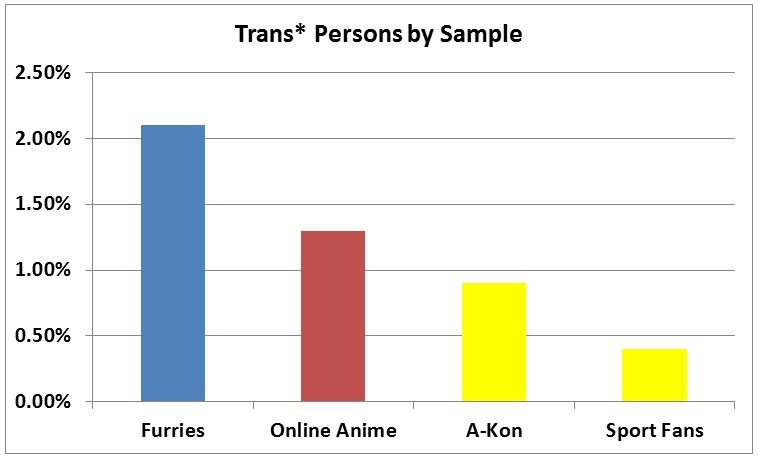
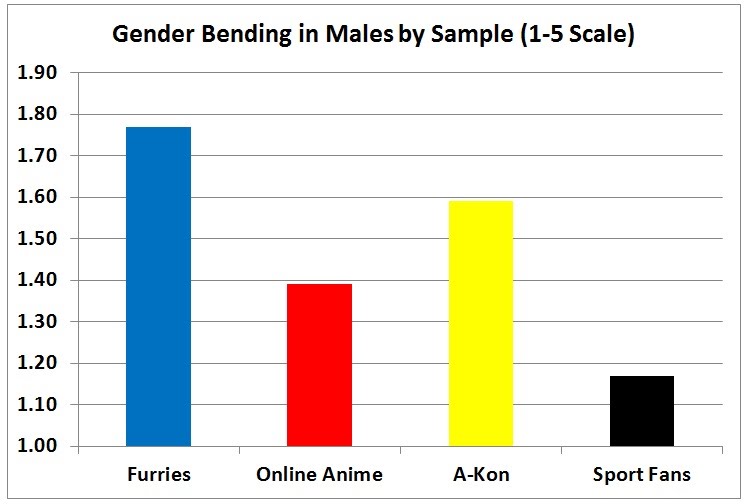
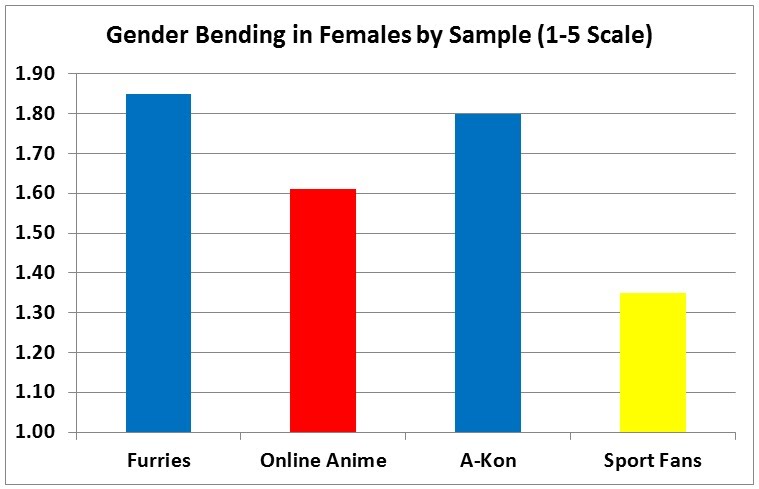
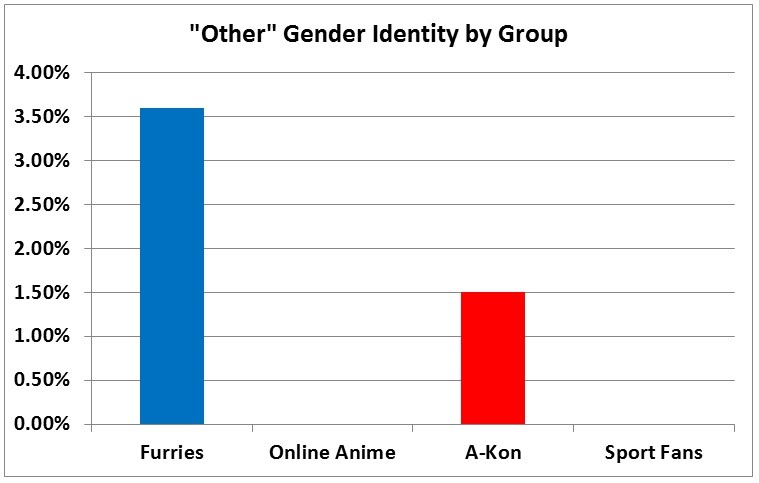
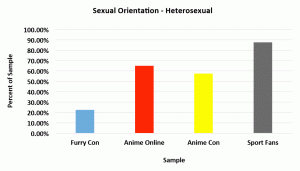
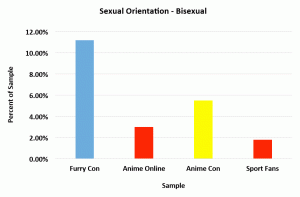
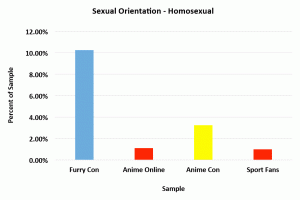
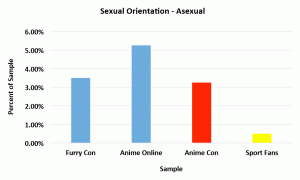
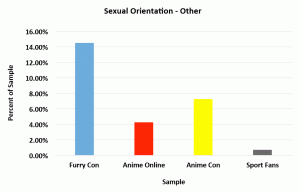
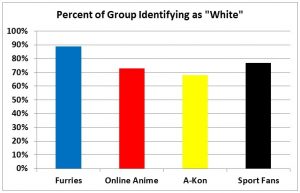
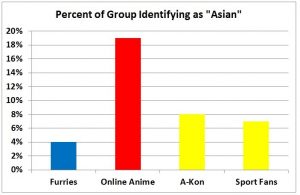
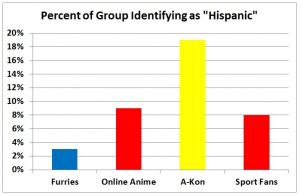
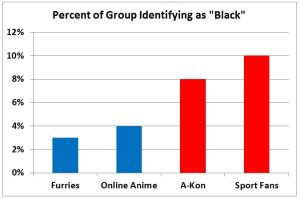
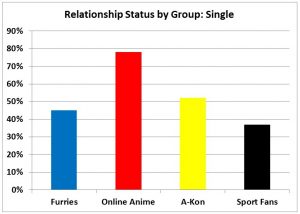
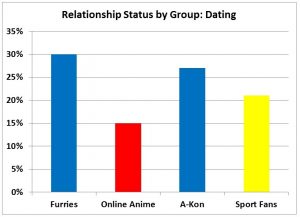
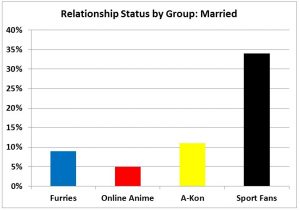
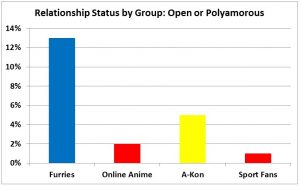
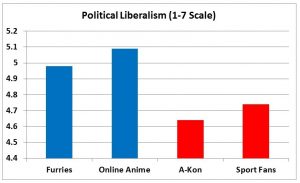
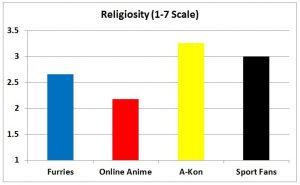
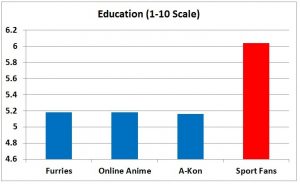
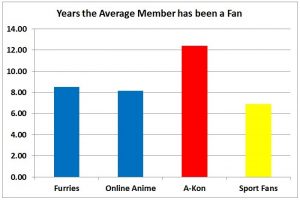
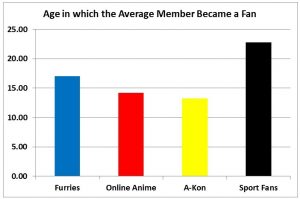
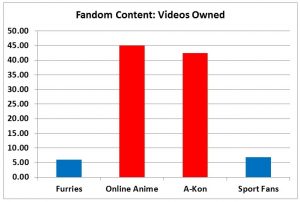
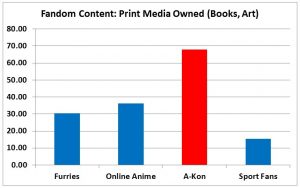
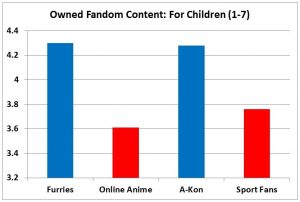
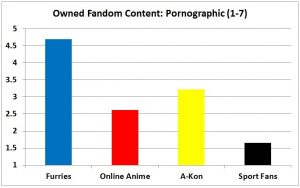
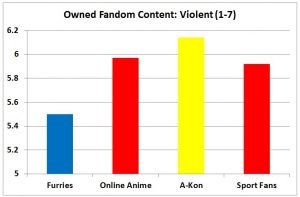
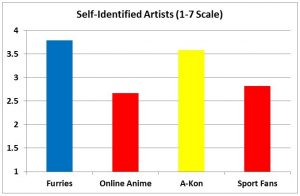
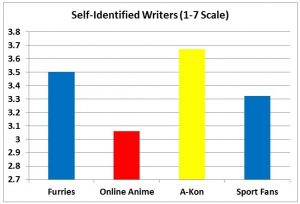
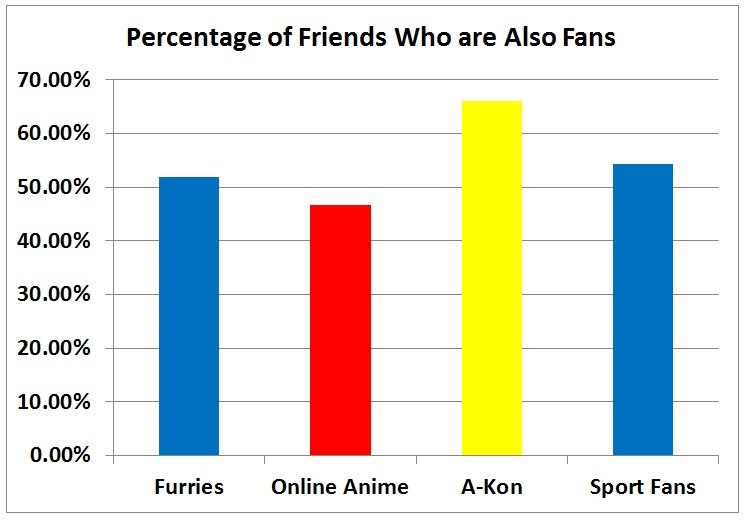
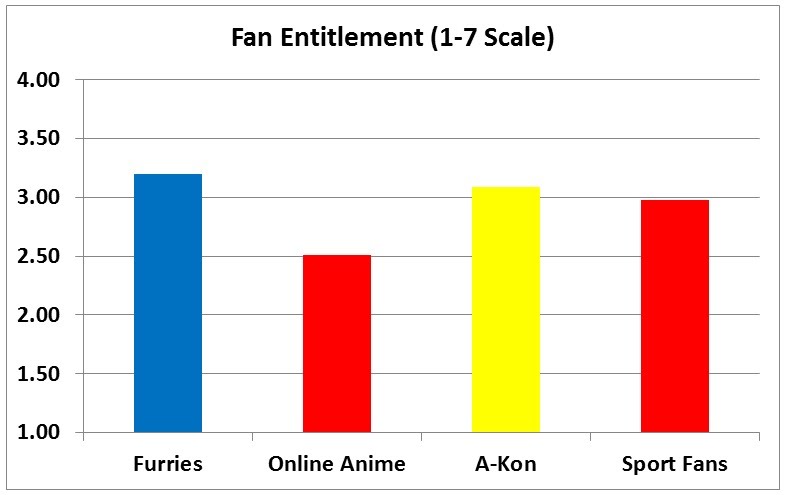
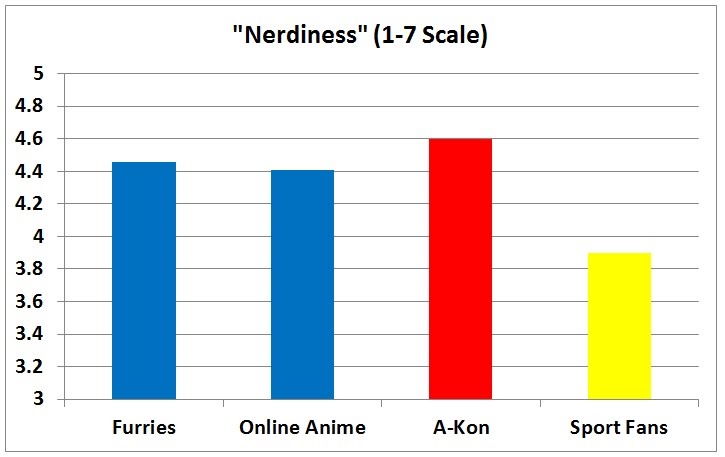
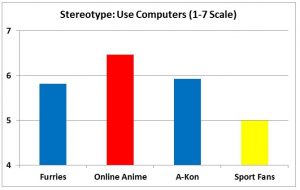
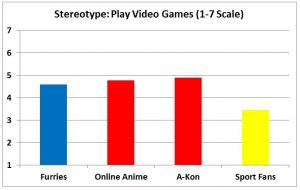
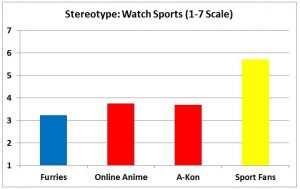

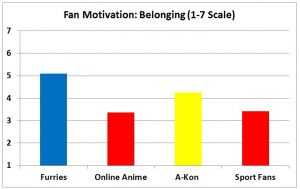
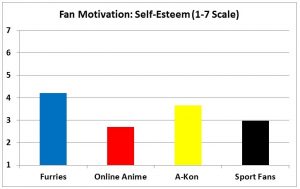
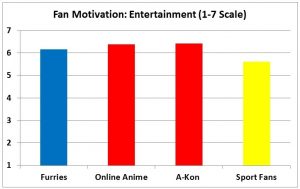
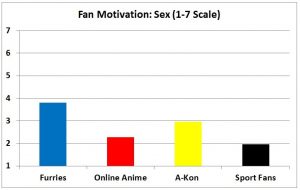
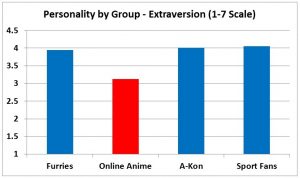
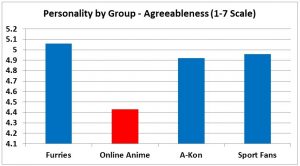
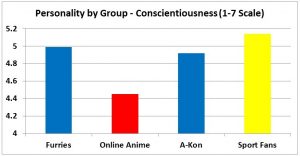
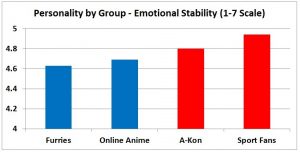
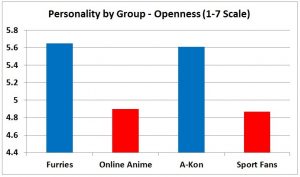
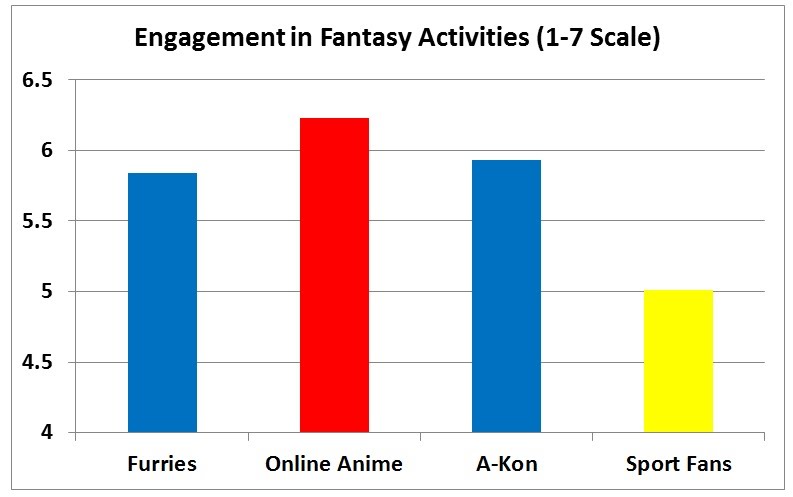
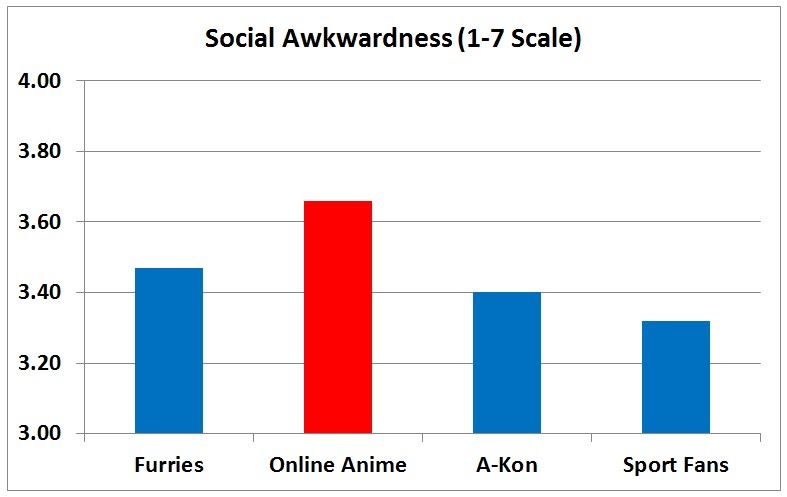
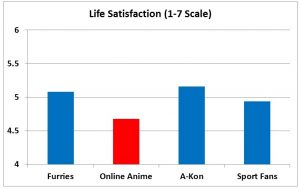

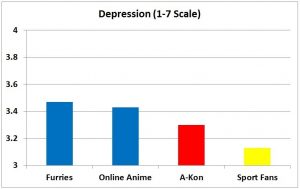
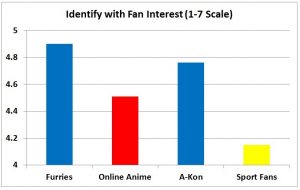
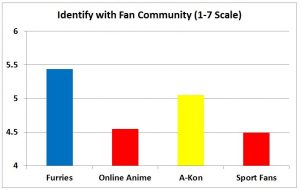

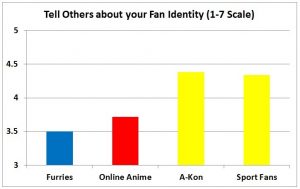
Recent Comments